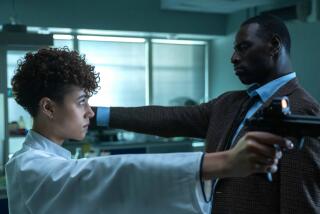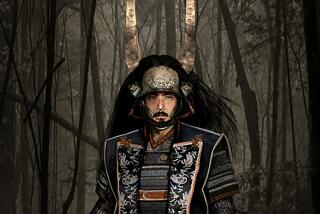Genre gets a true ‘Hero’
- Share via
There are a lot of on-screen heroes in “Hero,” so many exceptional warriors of both sexes that they barely fit on the film’s poster. But the real stalwarts of this visually spectacular motion picture, the people who will live on in martial arts legend, are all to be found behind the camera.
Led by director Zhang Yimou and dazzling cinematographer Christopher Doyle, the unseen “Hero” production team has made what just might be the most artistically sophisticated, most formally beautiful martial arts film the genre has seen. The most expensive production in China’s history as well as that country’s biggest-ever box office success, “Hero” is so good at what it does best that it makes its areas of weakness that much easier to overlook.
For although Ang Lee’s “Crouching Tiger, Hidden Dragon,” the film that introduced Hong Kong-style action cinema to mainstream American audiences, took pains to make an emotional connection to Western viewers, “Hero” has both a different agenda and a different effect.
What director and co-writer Zhang and his collaborators have come up with is more in the nature of a historical pageant, a film the director himself has said focuses on “grand spiritual ideas.” The result is a masterful if somewhat emotionally distant treatment of China’s early history that may prove more popular at home than here.
That history involves the king of Qin, the 3rd century BC ruler who forcibly joined his kingdom to six others and became the first emperor of all of China. As ruthless as he was far-seeing, the ruler of Qin has always been equally controversial and celebrated in China, his brutal ends-justify-means philosophy pleasing autocrats and troubling democrats. It’s a debate this film has apparently rekindled.
Almost as controversial has been the career of director Zhang, one of the most gifted members of the Fifth Generation, the first group of students to graduate from the Beijing Film Academy after the Cultural Revolution.
Zhang’s early works, gorgeous, psychologically acute melodramas like “Red Sorghum,” “Ju Dou” and “Raise the Red Lantern,” put the director on the international map. Then, coinciding with but not necessarily caused by problems with the government, he made such small-scale, neo-realist looks at China’s ordinary people as “Not One Less,” “The Road Home” and “Happy Times.”
With “Hero” and the forthcoming “House of Flying Daggers” (which debuted at Cannes), Zhang has changed aesthetic direction one more time, with a vengeance. He has apparently decided that if he’s going to make martial arts extravaganzas, he’s going to make the most eye-widening ones possible, and he has.
The story the director has co-written starts as a simple one, centering on a dialogue between the king of Qin and Nameless (Hong Kong star Jet Li), an accomplished assassin who’s spent the last 10 years (don’t even ask about time off) perfecting his deadly skills. Nameless has come to the king’s palace to announce that he’s vanquished three top-drawer fellow assassins whose determination to kill the monarch and stop his march of lethal conquest has been a living hell for the ruler for years.
Naturally, the king wants to know the details of Nameless’ exploits. How could someone whose name echoes Clint Eastwood’s Man With No Name character in those Sergio Leone westerns vanquish the legendary Sky (Donnie Yen) plus the deadly duo of Flying Snow and Broken Sword (top Hong Kong stars and frequent collaborators Maggie Cheung Man Yuk and Tony Leung Chiu Wai, respectively), not to mention Sword’s gifted assistant Moon (“Crouching Tiger’s” Zhang Ziyi)?
Nameless’ initial version of this tale, which has sexual jealousy as a motivation, is told in sequences in which everything -- from the costumes to the wall coverings to the scenery outside -- is dominated by the color red.
It turns out, however, that the story has two other versions, one told in a blue color scheme, the other in a white one. When you add in black scenes for the introductory sections and greens for a series of vivid flashbacks, you have five completely different visual schemes, which gives an idea of how stunning to the eye “Hero” turns out to be.
The color schemes are especially impressive because, except for some tinkering with the green, they were not created digitally but through old-fashioned means, which led to problems. “We couldn’t make some colors with the dye and water in Beijing,” costume designer Emi Wada reported. “Therefore we brought the dye from England and Japan and used mineral water to dye some of the fabric.”
Wada won the best costume design Oscar for her work on Akira Kurosawa’s epic “Ran,” and “Hero’s” passion for “Ran”-like battle scenes is one of several unexpected connections to the Japanese director’s work, including its “Rashomon”-like telling of a story from multiple points of view and a fondness for massive arrow attacks that echo his “Throne of Blood.”
Director Zhang, a former cinematographer, also clearly relished collaborating with a master like Doyle. A five-time winner of the Hong Kong Film Award for best cinematography (this film included) who’s best known for working with Wong Kar-Wai (on the languorously beautiful “In the Mood for Love”), Doyle is incapable of so much as a frame that is standard or uninteresting. His sense of epic scope and spectacle combined with his mastery of color, which he uses to evoke a range of intimate moods, makes watching “Hero” feel like living inside a glorious legend.
“Hero” looks the way it does because Zhang was willing to take enormous pains to get things just right. One of the film’s signature scenes, a stunning battle between Snow and Moon amid hypnotically swirling autumn leaves, is as unforgettable as it is because, as Zhang relates in the press notes, “I had a guy out there [Inner Mongolia] specifically to keep an eye on the leaves. He made videotapes of their progress as they turned from green to yellow.”
Then, during the shooting at the perfect golden moment, “we even implemented a leaf-classification system. Special-class leaves could be blown in the actors’ faces, first-class in front of them, second-class behind them and third-class were scattered on the ground.” This may sound obsessive, may in fact be obsessive, but the results are worth it.
Though the martial arts action is crisp and compelling (and the film’s use of blood is fortunately measured in drops, not gallons), some of the atmosphere surrounding the fighting may seem unusual for Western viewers. Great emphasis is laid on intertwined cultural and moral issues: the parallels between martial arts and music, the way fighting skill can be rooted in calligraphy, even the possibility of pacifism within a martial world.
So it’s a tribute to how much of a visual knockout this film is that even when you note the absence (though not for lack of trying) of an involving emotional relationship, “Hero” still offers enough to be required viewing. When those autumn leaves are twirling in that indescribably gorgeous fight scene, you will be grateful you decided not to wait for the DVD. See this on the biggest screen you can find and count your blessings.
*
‘Hero’
*
MPAA rating: PG-13 for stylized martial arts violence and a scene of sensuality
Times guidelines: almost blood-free
Jet Li...Nameless
Tony Leung Chiu Wai...Broken Sword
Maggie Cheung Man Yuk...Flying Snow
Zhang Ziyi...Moon
Chen Dao Ming...The King
Donnie Yen...Sky
Quentin Tarantino presents in association with Elite Group Enterprises Inc., an Edko Films, Zhang Yimou Studio production, released by Miramax Films. Director Zhang Yimou. Producers Bill Kong, Zhang Yimou. Executive producers Dou Shou Fang, Zhang Wei Pin. Screenplay Li Feng, Zhang Yimou, Wang Bin. Cinematographer Christopher Doyle. Editors Zhai Ru, Angie Lam. Costumes Emi Wada. Music Tan Dun. Production design Huo Ting Xiao, Yi Zhen Zhou. Running time: 1 hour, 39 minutes. In limited release.
More to Read
Only good movies
Get the Indie Focus newsletter, Mark Olsen's weekly guide to the world of cinema.
You may occasionally receive promotional content from the Los Angeles Times.











